So, you bought a new handgun and have the range bag and accessories you need. Now you are considering upgrading your pistol. Good for you.
For this article and purposes, we are talking about defensive handguns that will be used at home or in the gas station parking lot. I am not talking about a hunting handgun or a “duty” pistol like law enforcement carries. I am referring to what you bought either to conceal carry or put in a night stand where you can get to it to protect yourself and others.
The first thing to consider is do you really need to upgrade? Americans like buying stuff, thinking it will make them better shooters. In all reality, training and practice will make the largest and best impact on your shooting ability. At some point you may have a legitimate reason to upgrade your pistol.
First on my list is replacing the factory sights. Some pistols come with great factory sights, some, like my beloved Glock, come with crappy plastic ones that need to be replaces as soon as you can afford to. If you bought a used / trade-in gun with night sights, you probably should consider replacing them.
Night sights use tritium and it will fade out. A used law enforcement trade in with night sights is worth no more than one with normal sights. You might get about 12 years out of the tritium. You can read more here: https://www.nightfision.com/what-is-tritium.
Sights create almost as much debate as Ford vs. Chevy. There are all types and configurations from Three-dot, to Figure 8 and Popsicle (lollypop) styles. I have used dozens of different types and brands of handgun sights as well as played with various others. My list of what works for me is now very narrow, and I don’t buy gimmick sights.
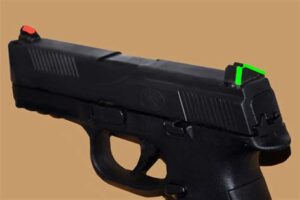
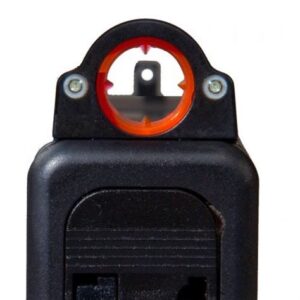
Other non gimmick sights still left me less than impressed.
The figure 8, whether they be the “Straight Eight” by Heinie or Night Fision’s “accur8” sights had me taking way too much time to align and create the 8. The sights with two dashes in the rear and a dot up front -0- look were good, however as my eyes got worse, I lost the dashes.
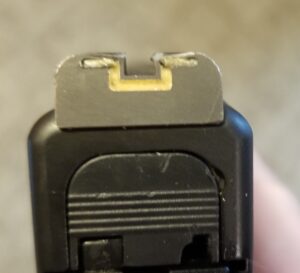
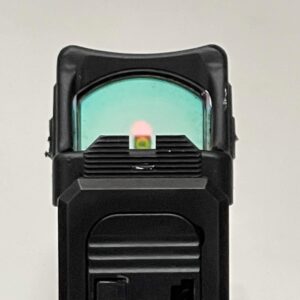
Fiber optic don’t pick up enough light in dusk to dawn situations. The red turns to black faster than the green in low light for me. In darkness they cannot be seen at all. They are also fragile and tend to break at the wrong time (in a tournament for me). Finally, their ability to withstand cleaning chemicals (you do clean your gun right?) is questionable.
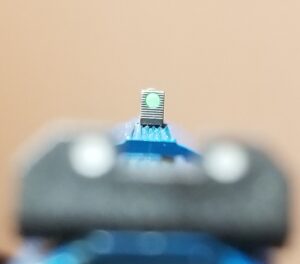
I prefer night sights because they allow me to see what I am aiming at in low light or no light.
I prefer a larger front sight in the 3-dot pattern. My reasoning is simple. With the other sights you have to decide how much space should be between the dots top to bottom for the distance you are shooting. You brain doesn’t have time for this. Just level the three dots horizontally and you are aligned.
When three dots are about the same size you can misalign them under stress. I have done it more than once. Now all my front sights are significantly larger than the two in the rear.
In the past I had to create my own by buying the Truglo TFO and installing only the rear sights and then using a XS Sights Big dot front sight. This meant buying two sets of sights to get one that worked for me. Fortunately, these days I can just buy the Truglo TFX or TFX Pro sights and get what I want.
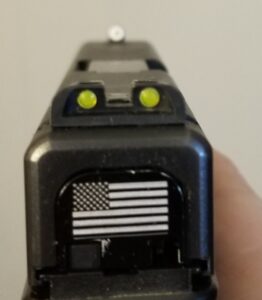
I make sure my rear sights do have the tritium in them and are not just a black U notch, I need to be able to align everything up in low or no light and the all-black rear sights disappear in those conditions.
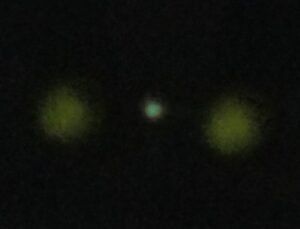
I no longer see the need for suppressor height sights. First, not all holsters support them, so you may get the privilege of buying another holster, 2nd I have found I can still line up the sights through the suppressor and aim effectively. Finally, with modern red dots (discussed below) you don’t need to “co-witness” your sights and dot (a fallacy I did at one time believe but experience taught me differently).
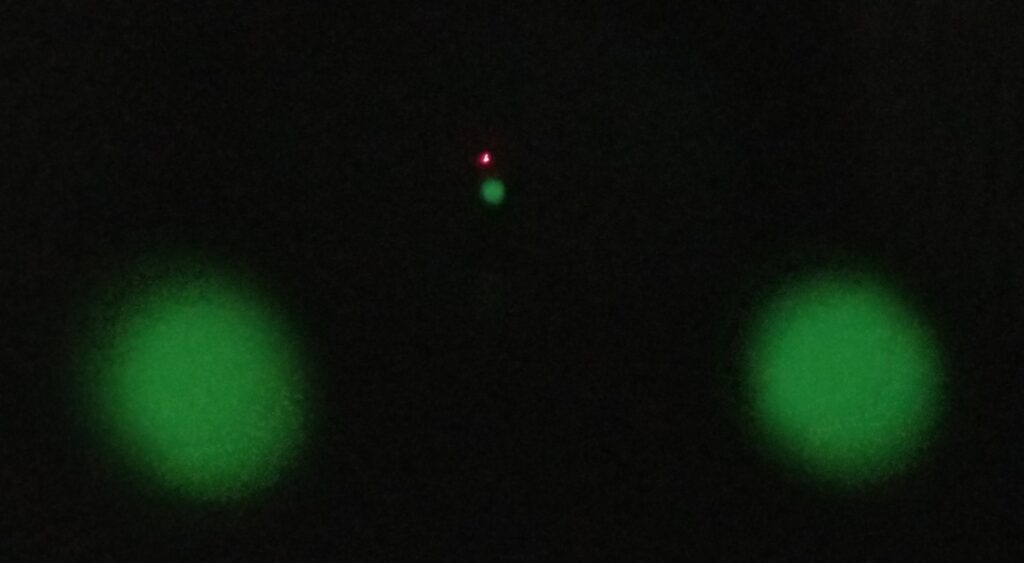
My simple suggestion is if your handgun did not come with a large front dot, two smaller rear dots all with tritium, then you should go and get a set of Truglo TFX sights or XS Sights R3D night sights installed (by the gun shop / gunsmith / armorer).
I recommend you get them with the white (or green) outer ring on the front sight, not the orange. I bought the orange and in darkness it is not as bright as the ones with the white or green.
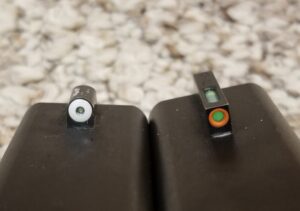
The next upgrade I recommend, if your pistol is setup to accept one, is a red dot sight (also called a reflex sight). I strongly recommend them.
Red dot sights allow you to focus on the target and the sight (red or green dot) is in focus too. If you use traditional sights, your focus has to go from the target to the front sight to be sure you are aligned. This is something that gets slower and slower with time due to aging eyes. You can read a couple of my articles on red dots sights here: http://the22man.com/?s=reflex+sight
Like standard sights, there are many brands of reflex sights. I have only used three, the Trijicon RMR series, Predator (Bass Pro off brand) and the Sig Saur Romeo Zero. I have seen and played with many others on friends’ guns. At this time, I can only recommend the Trijicon RMR series. The only thing I don’t like about them is that you have to take them off to replace the battery. Many other brands have side trays that allow you to replace the battery without removing the sight. I will leave the brand choice up to you, there are many good and great brands out there.
There are two primary color of dots offered, red and green. Green is much easier to see in bright daylight (remember what I said earlier about standard sights and the red fiber optic ones, the same applies in bright light here). It is also easier on my eyes in the dark than the red. Green does cost more, let your budget determine which you purchase.
Dots come in different sizes called MOA (Minute of angle) which is roughly one inch at 100 yards. You will need to decide how big you want that dot. I would base it on the firearms use. If you bought the pistol for personal defense, then you want to get on target quickly and stop the threat I would say the bigger the better, up to a point.
A one MOA dot is too fine and takes longer to acquire. Remember it covers 1 inch at 100 yards, thus .25 inches at 25 yards and .07 inches at 7 yards, the typical distance of most defensive shootings. A 3.25 MOA dot is much quicker to see in the sight and get on target. If this handgun is only for a defensive situation a 6 to 8 MOA dot will be fast to pickup so you are fast on target. I have tried the 1 MOA and have it on a competition gun, it is just too small.

I have the 3.25 MOA on my everyday gun, at times I have a hard time finding it, yet when I practice longer shots (75 to 100 yards) It is small enough I can still see the “head” of a silhouette target. Larger ones would be much faster for me to see and more than adequate out to 50 yards (it would only cover 3.25 inches of what I was shooting at). At 100 yards it would cover most of the head and thus make a more precise shot very difficult. I really hope I never need to take a shot that far in defense of others.
The sight generally come with manual or automatic brightness setting. Each has advantages and disadvantages. The automatic brightness get brighter in daylight and dimmer in dark. I own one of this type. It works great in bright to very low light situations. In the total dark it is so dim that I lose the dot. My every day carry gun is a manual adjusting.
While you don’t want to be screwing around with the brightness setting in a gunfight or self / others defense situation, you will learn (if you practice and take training) what setting is the best overall. Too bright of a setting during the day and the dots tend to no longer be a dot but appear to be a flame, oval or even lightning bolt shape. This can occur at any setting on the cheaper reflex sights. Too dim and you can’t see it and spend too much time searching for it instead of defending yourself.
The last option on red dots is to manually turn them off or automatic shut off. Again my EDC is a manual one that I never shut off. The battery life is long enough I change them on my birthday each year and don’t worry about it. The automatic shut off, turns on with movement. If your pistol is going to be in a quick access safe or night stand, the automatic version is probably just fine.
That’s enough for now, look for part 2 where I will discuss lights, extra magazines and some add-ons that have no real value.
Until we meet again, keep your booger hook off the bang switch until you are on target and ready to fire.
